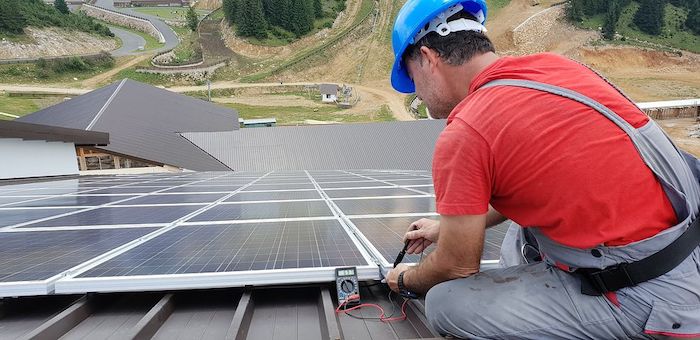New SMART Emergency Program Regulations: What Massachusetts customers should know
 The Commonwealth of Massachusetts began the "Solar Massachusetts Renewable Target" or "SMART Program" in 2018, in an effort to streamline and create a more accessible and cost-effective solar program for developers and electricity customers. The benefits of the program aimed to continue the Commonwealth's status as the most energy-efficient state in the country, while increasing the stability and permanence of the solar industry in the Northeast. As of 2020, the Solar Energy Industries Association (SEIA) ranks Massachusetts 8th in the nation for installed solar, up from 12th in 2019. While Massachusetts may not be the first place most people think of when they picture solar panels, the state's successful SMART Program has made Massachusetts a pioneer in the clean energy industry that other states are looking to follow.
The Commonwealth of Massachusetts began the "Solar Massachusetts Renewable Target" or "SMART Program" in 2018, in an effort to streamline and create a more accessible and cost-effective solar program for developers and electricity customers. The benefits of the program aimed to continue the Commonwealth's status as the most energy-efficient state in the country, while increasing the stability and permanence of the solar industry in the Northeast. As of 2020, the Solar Energy Industries Association (SEIA) ranks Massachusetts 8th in the nation for installed solar, up from 12th in 2019. While Massachusetts may not be the first place most people think of when they picture solar panels, the state's successful SMART Program has made Massachusetts a pioneer in the clean energy industry that other states are looking to follow.
On July 10, 2020, the Massachusetts Department of Energy Resources ("DOER") completed the required SMART Program 400MW review and emergency rulemaking, and published its final regulations, 225 CMR 20.00, with the Secretary of State. Recognizing that the COVID-19 pandemic continues to disrupt the solar industry, among its many adjustments to the regulations was an expansion of the COVID-19 extension to new SMART applications received through December 31, 2020.
Land use exceptions remained a prevalent topic in the final regulations. Projects qualifying for capacity under the original 1600MW program will remain eligible for SMART benefits, even if located on land designated as Critical Natural Landscape. However, projects qualifying for capacity under the expanded 1600MWs will be ineligible for the SMART Program if the project is sited in a Priority Habitat, Core Habitat, or Critical Natural Landscape. Projects will now have to meet certain conditions to be assessed under the former land use regulations, including having applied for an Interconnection Service Agreement (ISA) 135 business days prior to April 15, 2020, or having obtained a fully-executed ISA by October 15, 2020. Projects that have obtained a sufficient interest in real estate, or other contractual right to construct the Solar Tariff Generation Unit at the location specified in the ISA as of April 15, 2020, may also remain eligible under the previous 1600MW land use rules.

The final regulations recognized the benefits of solar tracking systems. They will now allow for single axis trackers to be eligible for the Tracker Adder - this is especially important given the stricter land use provisions, as developers may now need to find innovative ways to efficiently design and utilize smaller land parcels. The regulations also made behind-the-meter (BTM) systems eligible for the sale of Alternative On-Bill Credits.
The DOER made the following additional modifications to the Statement of Qualification Reservation Period Guideline:
- Clarifying that projects qualified as Community Shared Solar, that do not submit a claim with the CSS Adder, will have their base compensation rate decreased to the value in the lowest available Capacity Block, but will not be at risk of losing their Statement of Qualification outright;
- Establishing a process by which DOER will queue project applications if there is a rush of applications submitted following the issuance of interconnection agreements by a Distribution Company upon the completion of an Affected System Operator (ASO) study;
- Eliminating the requirement that projects obtaining an indefinite extension pending the authorization to interconnect must submit a claim within 10 business days of receiving the authorization to interconnect;
- Granting eligible Public Entity Off-taker Adder Solar Tariff Generation Units an initial Reservation Period of 18 months.
The publication of these new regulations is just one piece of the puzzle for maintaining the SMART Program. Several other guidelines related to this program are subject to revision, and expected in the coming weeks. Additionally, all regulatory changes that effect the tariff will now need to be implemented into each Electric Distribution Companies' tariffs, and undergo the administrative review of the Department of Public Utilities.

As COVID-19 continues to impact the industry, DOER may make additional adjustments to project timelines and deadlines. Additionally, as the SMART Program's tariffs are filed at the Department of Public Utilities and focus shifts to a tariff proceeding, there may be additional changes that occur. It is extremely important to continue to keep tabs on the DOER and SMART Program in order to stay up to date with their latest procedures and timelines. Always remember to consult with an attorney if the language of the new updates is unclear, or if you find that your Project is in a unique situation, to ensure you are receiving the greatest benefits of the new regulatory changes.
Tanya M. Larrabee is an attorney at the Boston law firm Sherin and Lodgen. She represents renewable energy clients in the acquisition, development, and financing of solar, wind, and energy storage projects, including advising on state incentive programs. She can be contacted via email at [email protected].
Sherin and Lodgen | www.sherin.com
Author: Tanya M. Larrabee
Volume: 2020 September/October









.png?r=5982)


